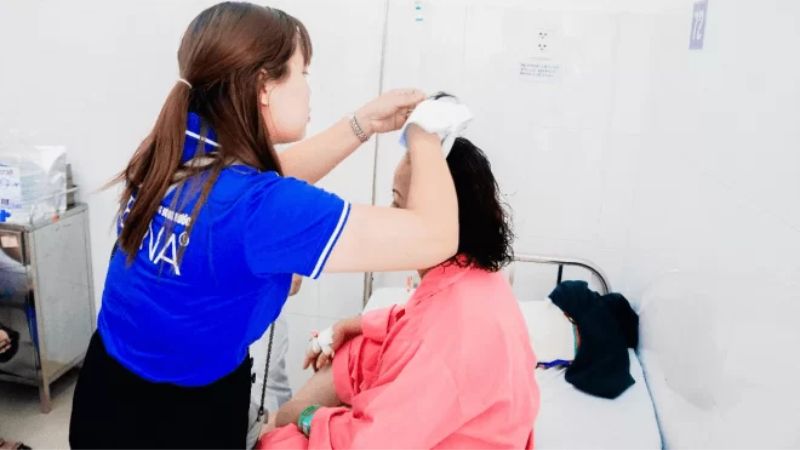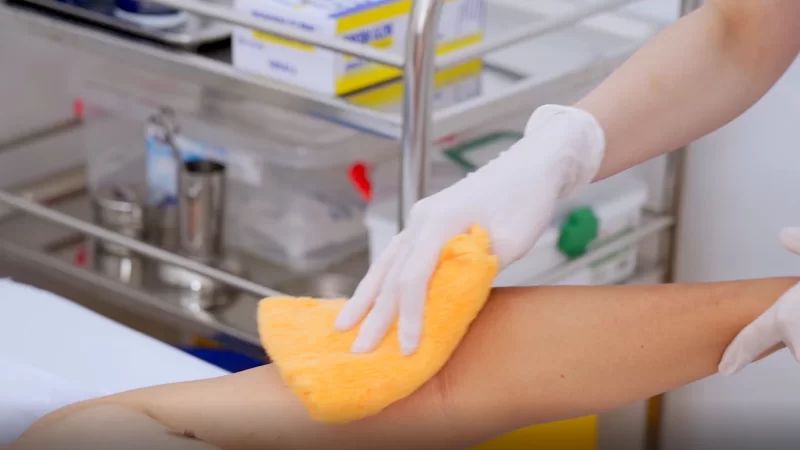Dry bathing is a convenient and effective personal hygiene method, suitable for various situations. However, it’s important to use it correctly to ensure skin safety. In this article, let’s explore what dry bathing is and how to effectively dry bathe for patients!
1 What is Dry Bathing?
Dry bathing is a method of maintaining personal hygiene without using water. Typically, bathing involves the use of water and soap, but with dry bathing, you’ll be using alternative products to cleanse and deodorize your body instead.
Dry bathing is incredibly useful in special circumstances, such as when access to clean water is limited, during long travels, or for individuals who are ill or elderly and may have difficulty bathing conventionally.
 Dry bathing is a method of personal hygiene that doesn’t involve the use of water
Dry bathing is a method of personal hygiene that doesn’t involve the use of water
2 Is Dry Bathing Good?
While dry bathing is becoming increasingly popular, some people wonder if it’s a good option. Let’s explore the specific advantages and disadvantages of dry bathing to understand it better!
Benefits of Dry Bathing
-
Convenience: Dry bathing is extremely convenient when water is scarce or unavailable, such as during travel, camping, or in areas with limited water access.
-
Time-saving: The dry bathing process is much quicker than traditional water bathing, making it ideal for busy individuals.
-
Suitability for the ill or elderly: Those who have difficulty bathing conventionally can maintain their personal hygiene through dry bathing.
-
Instant deodorization: Dry bathing products typically contain deodorizing agents, effectively eliminating body odor.
-
Water conservation: By not using water, dry bathing contributes to water conservation.
 Is Dry Bathing Good?
Is Dry Bathing Good?
Drawbacks of Dry Bathing
-
Not a complete substitute for water bathing: Dry bathing cannot provide the same deep cleanse as water and soap, and some residue and dirt may remain on the skin.
-
Potential skin irritation: Some dry bathing products contain chemicals or fragrances that may irritate sensitive skin.
-
Not recommended for long-term use: Dry bathing is best used as a temporary solution. Prolonged avoidance of water bathing can lead to skin issues.
-
Incomplete bacteria removal: Dry bathing is less effective at removing all bacteria, which can accumulate on the skin over time.
3 Dry Bathing for Patients
Step 1 Prepare the necessary items
- Dry bathing products: dry bath foam, spray, or powder
- Soft towels
- Medical gloves
Step 2 Wash your hands thoroughly
Before starting, the caregiver should wash their hands thoroughly with soap and water or use a hand sanitizer. Ensure that the room is warm and draft-free for the patient’s comfort. Position the patient in a comfortable position, either lying down or sitting up, depending on their health condition.
Step 3 Dry bathe the face and neck
Use a towel dampened with the dry bath product to gently wipe the face and neck. Start with the face, then move down to the neck, avoiding vigorous rubbing, and being careful around the eyes.
Step 4 Wipe the arms and underarms
Continue by cleaning the arms and underarms. Start wiping from the upper arms down to the hands, paying special attention to areas with dead skin, such as the elbows, fingers, and underarms.
Step 5 Wipe the chest and abdomen
After cleaning the arms and underarms, move on to the patient’s chest, followed by their abdomen and navel.
Step 6 Wipe the back
At this step, help the patient sit up or lean forward to wipe their back. Gently wipe the back from top to bottom and from left to right.
 Dry Bathing for Patients
Dry Bathing for Patients
Step 6 Wipe the legs and feet
After wiping the back, the patient can lie back down. Continue by wiping the legs, paying attention to the toes and heels.
Step 6 Clean the intimate areas
Use a separate towel or specialized product to gently and thoroughly clean the intimate areas.
Step 7 Disinfect and dry
After cleaning the body, use a soft towel to dry the skin. You can apply moisturizer or baby powder if needed to prevent dry skin.
4 Important Considerations for Dry Bathing
When dry bathing, especially for patients, the elderly, or those with sensitive skin, keep the following considerations in mind to ensure effective and safe cleaning:
- Use high-quality dry bathing products from reputable brands to avoid harsh chemicals or fragrances that may irritate the skin.
- Test the product on a small patch of skin before using it on the entire body to check for any allergic reactions or irritation.
- Use soft towels and gentle motions, avoiding vigorous rubbing to prevent skin damage. It’s best to use separate towels for different body areas, especially the face and intimate regions, to prevent bacterial transmission.
- Perform dry bathing in a warm and draft-free room to ensure the patient doesn’t feel cold.
- Ensure the patient remains in a comfortable position, either lying down or sitting up, depending on their health condition.
 Important Considerations for Dry Bathing
Important Considerations for Dry Bathing
Now you know all about dry bathing and how to effectively dry bathe for patients. Remember to follow these steps to ensure a thorough and safe dry bathing experience!
Source: Long Chau Pharmacy


































